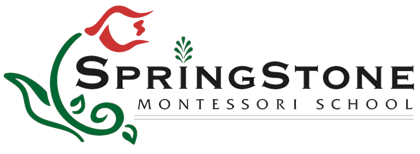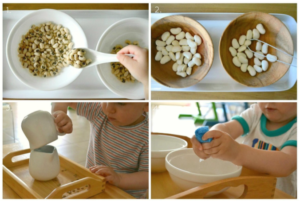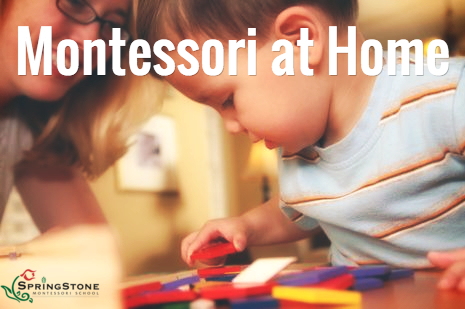The Importance and Characteristics of Practical Life Activities
Why are Practical Life activities such an important part of the Montessori Early Childhood Learning environment?
We always speak about real materials and real experiences, and Practical Life activities offer just that.
Practical Life activities are the activities of everyday life, and they are involved in all aspects of life. The child observes these activities in the environment and gains knowledge through the real experience of how to accomplish life skills in a purposeful way. These activities are cultural and specific to the child’s time and place. Practical Life activities help to give the child a sense of being and belonging, established through participation in daily life with us.
Children strive to be helpful in their family environment from a very young age. They want to make a difference and contribute. Even if they are still developing many of their skills, they need to be allowed to practice. Activities include sorting, tweezing, tonguing, pouring, washing, planting, polishing, balancing, cutting or other fine motor and hand-eye coordination focused activities.
When you allow your child to help, make sure you don’t expect them to do it to your standard! They are practicing their skills, and you need to acknowledge just that.
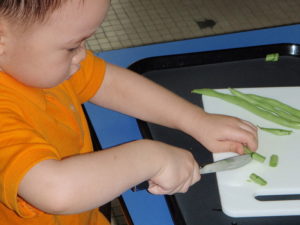
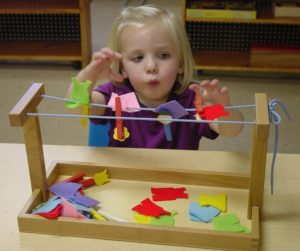 Characteristics of Practical Life Activities
Characteristics of Practical Life Activities
- Reality-Based: The activities need to be based on real life. We wash dirty dishes with real soapy water, we clean shoes with real polish, and we cut fruit with a real knife. We learn safety by practicing safety
- Not Limited: The activities are limitless, as they will depend on the cultural and environmental needs, which will vary greatly from environment to environment and country to country. We need to provide a variety of activities to challenge our curious minds!
- One of Each: While there is no limit to the amount of practical life activities you can have in the environment, there should only be one of each activity. This helps the child to learn that he has to wait, as life is not always about immediate gratification. As a result, the materials become more valued. You can always have spare activities in storage to swap out if one gets broken, but there should only be one on the shelf at a time.
- Self-Contained: The materials are contained in a basket, tray or set out on a stand in a particular space. All materials should be complete, prepared and ready for use. We, the teachers, are responsible for making sure that the activity is prepared with everything the child needs for successful completion of the activity. This helps the child’s human tendency and sensitive period for order, and it is this external order that helps the child to internalize order.
- Complete: The activity needs to be complete. If something needs to be replaced at the end of the activity we show the child how to re-stock the activity. If the activity is incomplete for whatever reason, broken or missing component, we need to complete it or remove it from the shelf.
- Sequential: Each activity has a beginning, middle and end. One of the cues for beginning an activity can be to put on an apron. The middle is the activity itself. The end represents cleanup, returning the activity to its original location and returning the apron to its proper location.
- Manageable Container: The containers must not be too small or too big for the child to handle. Trays and baskets need to be deep enough to hold contents and thereby prevent items falling out when being carried.
- Functional: All materials should have a clear purpose and function. There is nothing worse than a utensil that does not do the intended task. The knife really needs to cut. If the utensil does not do its intended task, then the child will look for something else to do with it (inappropriate use). The child will think that he is unable to do the task that he has seen so many others do. We need to be mindful of the child’s abilities when testing the materials.
- Child-Sized: Materials must be proportional to the child. Even the size of a sponge or brush must fit the child’s hand so the child can use it successfully.
- Proportional Items: The materials of an activity must be proportional to each other and functional in terms of size. For example, the bucket must be small enough for the child to handle but big enough to hold all the water necessary for the exercise.
- Natural Materials: Natural materials offer more opportunities for multi-sensorial experiences and are more aesthetically pleasing and feel better to the touch.
- Easily Cleaned: The materials must be cleaned regularly and be hygienic to use. Natural materials are easier to clean and harbor fewer bacteria.
- Safety: While materials need to be functional, the priority is safety. The use of non-toxic materials is recommended. Sharp objects need to have rounded ends, and corners that are sharp should be sanded or covered.
- Orderly: Order must always be in a logical sequence, whether it is how you present the material or lay the activity out on the shelf. Before a presentation, we lay out the material in order of use. The activities on the shelf should be ordered from simple to more complex from left to right.
